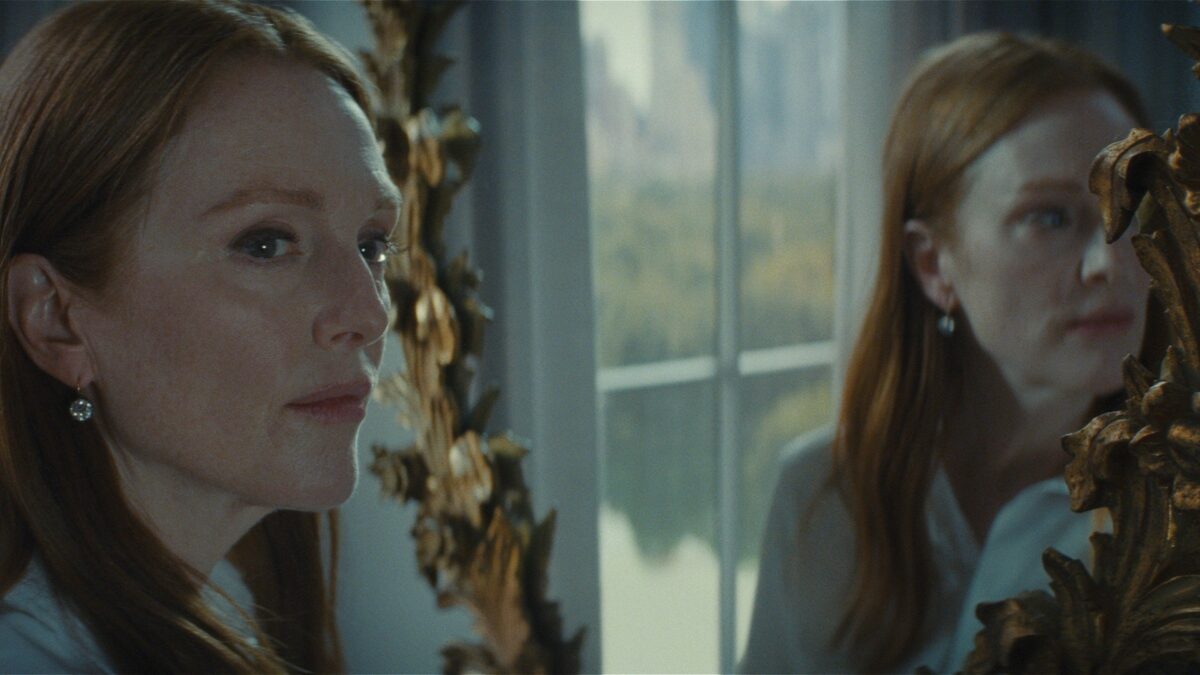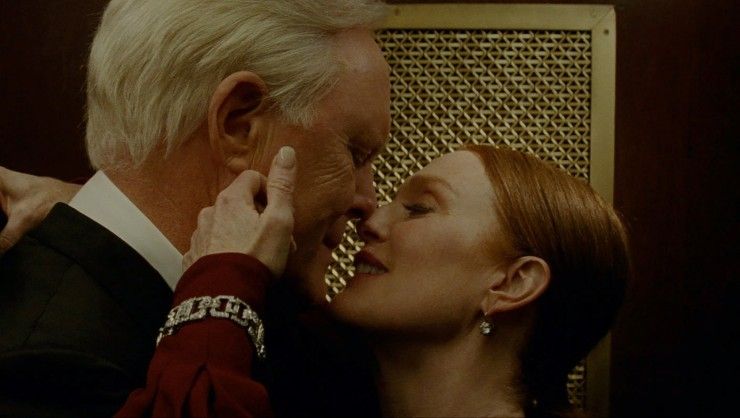
Things are about to get sharper.
Breaking down the narrative jigsaw puzzle of a psychological thriller like Sharper is no easy feat, but there is always a bolt of enjoyment that comes from watching a con unfold, moving back and forth, as characters grow, change, and shape a larger story than the audience could ever expect.
In Sharper, motivations are suspect, and expectations are turned into chaos as a con artist takes on Manhattan billionaires. With multiple players and more plot twists than one can count, Yan had the delicate task of delivering audiences with a puzzle that kept them guessing and doubting the characters’ intentions at every turn. Editing, an already essential tool to great filmmaking, becomes even more vital when weaving together a story that has multiple moving parts separated across a non-linear timeline.
No Film School had a chance to chat with Yan Miles, the Emmy-winning editor behind A24’s and Apple TV+’s recent crime thriller, Sharper, starring Julianne Moore, Sebastian Stan, and John Lithgow. In the interview, Miles shares insights into editing non-linear story, his approach to creating multidimensional characters, and his advice for aspiring editors.
NFS: The events in Sharper are not organized chronologically. How did you approach that, and what were some advantages of editing this story in chapters?
Yan Miles: The script was always non-linear until the Madelaine chapter, where we ran in the current timeline before the last series of flashbacks. In the cutting process, giving her a final wrap-up with a name card and her own chapter felt right, so we jumped back in time to see her leave Max and Madeline on the plane.
The entire film is really about Sandra/Sandy; with all the chapters, we often lean into characters’ back stories as useful character development and a way to understand motivations. For example, Sandra meets Tom in his bookstore: they fall in love, cook, drink, talk books, and make love.
In chapter two, Sandy meets Max, and he trains her for the bookstore con on Tom. He goes as far as asking her to seduce a man in a hotel bar back to his room. In a non-linear chronology, it is a joy to experience a character’s why and how. It creates much more complex storytelling because we get to experience this one story from the perspective of multiple people.
NFS: We meet each character in their own little chapter. Which one of those chapters was most intriguing for you to edit?
Miles: I loved all the chapters. Each had a similar motive, with the character being alone and the music playing in the background. Sandy, the final chapter, is the most intriguing as it shows her redemption. We explore why and how she did what she did. She initially lied and cheated to survive in life, and Max capitalized on this aspect of her.
When you break down her chapter, you can see that she learned a lot from Max, but then she became a teacher to tricky Max and Madeline. Why? You can’t cheat an honest person, and Sandy truly felt for Tom. It’s the moment when the human condition shines in, and we see who Sandy really is and what limits she is willing to safeguard or sacrifice.
NFS: Since the story is based on chapters, they could have been arranged in multiple ways. Was the idea always to start with Tom and finish with Sandy?
Miles: As I explained above, the script was always organized in chapters apart from Sandy. However, we re-ordered the chapters into the linear version before we started editing to better understand the story. Ben, the director, placed whiteboards around the room, and we scribbled the linear version of the story. There are time gaps between each part of the storyline, so we would imagine our characters’ journey and fill in those gaps to inform the narrative. It was a very rewarding and creative process.
NFS: It also seems like we are introduced to Madeline, Max, and Sandy twice. Once when we meet their curated person and the other time when we discover their true identity. Like when we meet Sandy being a perfect match for Tom in his chapter, and then we meet a whole new version of her when she meets her parole officer in the restaurant. How did you balance characters’ two identities while editing?
Miles: It reflects the duplicitousness of the human character that defines us all. We can be empathetic to others, although we sometimes fail at it. The same goes for love. Sharper is a con film, but for me, it’s also a slice, a mirror of life. Sandra seduces Tom, and he falls in love with her, the real her. Sandra meets Max, and she falls for him showing her need to be loved. Max needs Madeline to love him, and it’s a broken truth that he tries to hide.
Richard loves Madeline because he looks for happiness due to his age and sickness. Madeline loves money and the thrill. Even with the billions, she steals a ring because she can’t help herself. So by delving into the brilliant performances, we tried to understand what people are motivated by and the complexity of the desire for money and happiness.

NFS: What were some of the little details you focused on to create such multidimensional characters in a heist movie?
Miles: Based on the trailer, the audience knew it would be a con movie and the twist that comes with that. The key is that Sharper is more about the human condition than just a con. The big question is, who we really are? When do you really meet the real Max or Madeline? For me, the characters were able to straddle both duplicitous parts of themselves very well.
There is a scene when Madeline explains to Tom, “We are all human, just doing the best we can,” and she summarizes the multidimensional story we were aiming at, con or non-con.
NFS: You edited many prominent projects in the past. Do you have one that really stuck with you or provided you with the most creative opportunities?
Miles: I’ve enjoyed and learned from all projects I worked on. They all brought me new elements to sharpen my storytelling. Sherlock unlocked some creative shackles. Nick Hurran, the director, would always show me his side scripts, and on top, he would write “BE BOLD,” and it’s exactly what I did.
Similarly, I worked with Ben Caron before, but he always surprises me with his creativity. Working with him is magical and robust. Editing is interesting because you start with a script written by skilled writers, shoot actors with a vastly talented crew, and then cut this together to examine the story we all embarked on together. Easy, right? Nope, because creativity doesn’t work this way. For me. it’s not bottled, distilled, or formulated. It’s shared. It always amazes me how much we can learn from each other.

NFS: What advice would you give to aspiring editors? Or what is something you wished you knew before first starting?
Miles: I’ve taught editing to students at university, and I’ve learned that editing is difficult to summarize or teach because we all see things differently. I am very grateful for having a career in editing, which I’m profoundly proud of. I often remind myself of my journey here, and it was tough. I remember being an assistant editor and desperately wanting to sit in the editor’s chair. Now I realize that every editor subconsciously enlightened me and taught me something.
So ultimately, no time really was wasted. Today with social media platforms like TikTok, we are surrounded by editing and creativity. I’m in awe of this, so I wish I knew to appreciate all the opportunities you get before reaching the editor’s chair.














